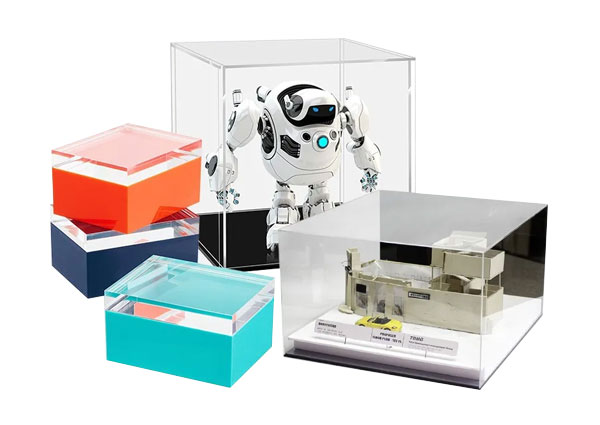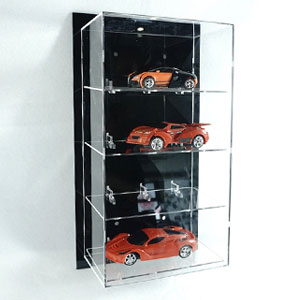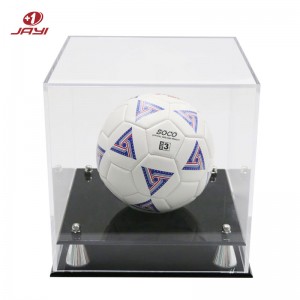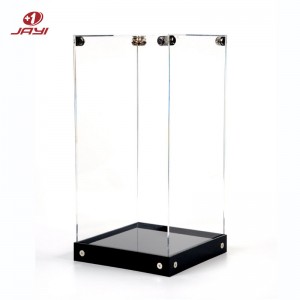Choosing between glass and acrylic for your display case can make or break how your valuables are showcased. But which material truly offers better clarity, durability, and cost-efficiency? This question has sparked a long-standing debate in display case design.
The choice of material for a display case is not just a matter of aesthetics. It impacts functionality, lifespan, and the overall user experience. According to a 2024 retail design survey, 68% of buyers prioritize material durability over aesthetics when selecting display cases. This shows that while glass and acrylic have unique visual appeal, the practical aspects of the material are often at the forefront of decision-making.
In the following sections, we will conduct a comprehensive, data-driven comparison of glass and acrylic to help you make an informed decision for your display case needs.
Core Contrast Dimension
1. Clarity & Aesthetics
When it comes to clarity, glass is often lauded for its high light-transmittance rate. Standard glass has a transmittance of about 92%, allowing for a crystal-clear view of the items inside the display case. However, as the thickness of the glass increases, so does the risk of reflection. In brightly lit environments, this can be a significant drawback, as it may create glare that obscures the view of the displayed objects.
On the other hand, acrylic has a slightly lower transmittance rate of around 88%. But its real advantage lies in its lightweight nature and the ability to maintain good optical clarity even in thinner sheets. This makes it an excellent choice for curved designs. For example, in many modern museums' cultural relics display cases, acrylic is used to create seamless, curved enclosures that provide a unique and unobstructed view of the artifacts. The flexibility of acrylic allows designers to create more dynamic and visually appealing display cases.
2. Weight & Portability
Weight is a crucial factor, especially when the display case needs to be moved frequently or installed in areas with weight-bearing limitations.
Glass is significantly heavier than acrylic. For a 1 square meter sheet, glass typically weighs around 18 kg, while acrylic weighs only about 7 kg, making it 2 - 3 times lighter.
This weight difference has a practical impact on various applications.
In the retail industry, brands like IKEA often opt for acrylic display cases in their stores. These lightweight cases are easier to transport, install, and rearrange as needed.
In exhibition settings, where display cases may need to be moved during the setup and takedown of shows, the portability of acrylic can save a great deal of time and effort.
3. Impact Resistance
One of the most significant differences between glass and acrylic is their impact resistance.
Glass is well-known for its fragility. According to ASTM (American Society for Testing and Materials) test data, the impact resistance of glass is only about 1/10 that of acrylic. A minor impact, such as a bump or a fall, can easily shatter glass, posing a risk to both the displayed items and anyone in the vicinity.
Acrylic, on the other hand, is highly shatter-resistant. This property makes it a popular choice for environments where there is a higher risk of accidental impact. In children's museums, for example, acrylic display cases are used to protect exhibits from curious hands and potential knocks. Sports goods stores also often use acrylic cases to display equipment, as they can withstand the rough handling that may occur in a busy store environment.
4. UV Protection
Exposure to ultraviolet (UV) light can cause damage to both the display case material and the items inside.
Standard glass offers little to no UV protection. This means that valuable items such as artworks, antiques, or collectibles are at risk of fading or deteriorating over time if displayed in a glass case without additional protection. To counter this, an extra UV - filtering film needs to be applied, which adds to the cost and complexity.
Acrylic, on the other hand, has a natural ability to resist UV light. 3M laboratory tests on material yellowing rates have shown that acrylic is much more resistant to the effects of UV exposure compared to glass. This makes it an ideal choice for long-term display of sensitive items, as it helps to preserve their color and integrity without the need for additional treatments.
5. Cost Analysis
Cost is always a significant consideration when choosing a material for display cases.
Glass generally has a lower initial cost, which makes it an attractive option for those on a tight budget. However, this cost-effectiveness may be short-lived. Glass is more prone to breakage, and the cost of replacement and maintenance can add up over time. Statistics show that in high-traffic areas, glass display cases may need to be replaced more frequently due to accidental damage.
Acrylic, on the other hand, has a higher upfront cost, typically 20 - 30% more expensive than glass. But when considering the long-term, its lower maintenance requirements and longer lifespan make it a more cost-efficient option in the long run. A 5-year use simulation calculation shows that the total cost of ownership for an acrylic display case is often lower than that of a glass one, especially when factors such as replacement and maintenance are taken into account.
6. Plasticity
In the design and manufacture of display cabinets, the plasticity of materials is the key factor affecting the diversity and uniqueness of its shapes.
Although glass can be shaped at high temperatures, it is difficult to process. The shaping of glass requires high-precision equipment and professional technology, because the glass is prone to crack during the heating process, and once the shaping fails, it is difficult to carry out secondary processing. This makes the glass in the production of complex shape display cabinets subject to many restrictions, most of them can only be made into more regular shapes, such as square, rectangle, and other simple planar structure display cabinets.
Acrylic shows high plasticity and customizability. It is a thermoplastic that has good fluidity after heating and can be easily processed into a variety of complex shapes. Through hot bending, splicing, injection molding, and other processes, acrylic can produce a variety of unique shapes of display cabinets to meet the designer's pursuit of creativity and personalization.
Some brands store in the unique shape of the display rack, as well as the art exhibition in the shape of the different exhibits display boxes, acrylic material. In addition, acrylic can be combined with other materials to further expand its design possibilities and bring more innovation to the design of display cases.
Customize Your Acrylic Display Cases and Boxes Item! Choose from custom size, shape, color, printing & engraving options.
As a leading & professional acrylic products manufacturer in China, Jayi has more than 20 years of acrylic display case custom production experience! Contact us today about your next custom project and experience for yourself how Jayi exceeds our customers' expectations.

Scenario-based Recommendation
1. When to Choose a Glass Display Case?
In high-end retail scenarios, such as jewelry or watch displays, glass is often the material of choice.
The need for absolute clarity and a luxurious look is paramount in these settings. The High-end jewelry brands require the crystal-clear transparency of glass to showcase the brilliance and details of their precious gemstones and intricate watch designs.
In static environments like the main exhibition areas of museums, glass can also be a great option. Since the display cases are not frequently moved, the weight and fragility of glass are less of a concern.
The timeless elegance of glass can enhance the display of historical artifacts, providing a sense of authenticity and grandeur.
2. When to Choose a Acrylic Display Case?
For high-traffic areas, such as mall POP (Point-of-Purchase) stands and interactive display cases in educational institutions, acrylic is the better choice.
The high impact resistance of acrylic ensures that the display cases can withstand the constant movement and potential collisions that occur in these busy environments.
When there are special shape requirements, acrylic's flexibility gives it an edge. Apple Store's use of a curved acrylic display case is a prime example.
The ability to mold acrylic into unique shapes allows for creative and eye-catching display designs that can enhance the overall brand experience.
Common Misconception
Myth 1: "Acrylic = Cheap"
There is a common misconception that acrylic has a cheap appearance.
However, the 2024 window display design of LV proves otherwise. LV used acrylic in their window displays to create a modern and sophisticated look.
Acrylic's versatility allows it to be finished in a way that mimics the look of high-end materials, and when combined with proper lighting and design, it can exude luxury and elegance.
Myth 2: "Glass Is More Environmentally Friendly"
Once you have placed an order with a China acrylic tumbling tower manufacturer, you can expect to receive regular updates on the progress of your order. The manufacturer will keep you informed about the production schedule, any potential delays, and the expected delivery date.
If you have any specific requirements or changes to the order during the production process, the manufacturer will work closely with you to accommodate your requests. They understand that flexibility is key in today's business environment, and they are committed to providing you with the best possible service.
In addition, China manufacturers are transparent about the production process and are willing to share information with you. You can request to visit the manufacturing facility to see the production process firsthand, or you can ask for photos and videos of the production line to ensure that everything is proceeding as planned.
Industry Expert Advice
A museum curator once said, "For artifacts that are frequently on tour, acrylic is the bottom line for transportation safety." The high-risk nature of transporting valuable artifacts makes the shatter-resistance of acrylic indispensable. During the often - -bumpy journey of traveling exhibitions, acrylic display cases can better protect the precious items inside.
A retail designer also shared a useful tip: "Combining glass and acrylic - using glass on the outer layer for a premium look and acrylic as the inner lining for shock absorption." This combination can take advantage of the best properties of both materials, providing both the high-end aesthetic of glass and the practicality of acrylic.
Suppose you are excited about this unique acrylic display case. In that case, you may wish to click on further exploration, more unique and interesting acrylic display boxes are waiting for you to discover!
FAQ
Q1: Can Acrylic Scratches Be Repaired?
Q2: How Often Should Glass Display Cases Be Replaced?
Conclusion
To help you make a quick decision, we have created a decision-making flowchart.
First, consider your budget. If cost is a major constraint, glass may be a better initial choice, but remember to factor in long-term maintenance costs.
Second, think about the usage scenario. If it's a high-traffic or frequently-moved location, acrylic is more suitable.
Finally, assess the security needs. If protecting valuable items from impact is crucial, acrylic's shatter - resistance makes it the top pick.
Post time: Feb-07-2025




